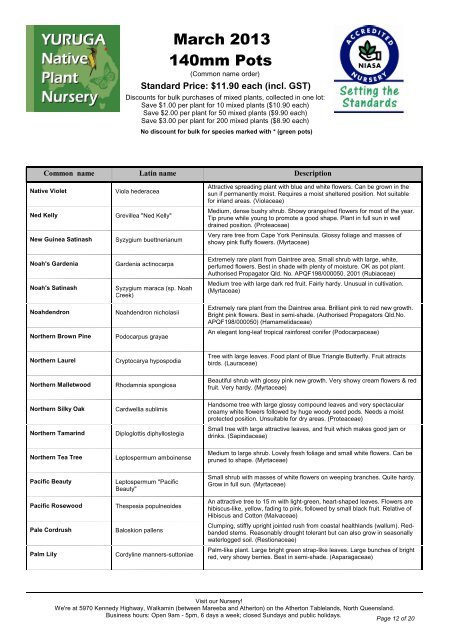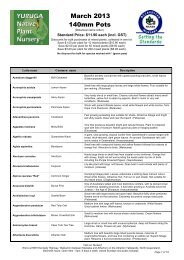in common name order - Yuruga Nursery
in common name order - Yuruga Nursery
in common name order - Yuruga Nursery
You also want an ePaper? Increase the reach of your titles
YUMPU automatically turns print PDFs into web optimized ePapers that Google loves.
March 2013<br />
140mm Pots<br />
(Common <strong>name</strong> <strong>order</strong>)<br />
Standard Price: $11.90 each (<strong>in</strong>cl. GST)<br />
Discounts for bulk purchases of mixed plants, collected <strong>in</strong> one lot:<br />
Save $1.00 per plant for 10 mixed plants ($10.90 each)<br />
Save $2.00 per plant for 50 mixed plants ($9.90 each)<br />
Save $3.00 per plant for 200 mixed plants ($8.90 each)<br />
No discount for bulk for species marked with * (green pots)<br />
Common <strong>name</strong> Lat<strong>in</strong> <strong>name</strong><br />
Description<br />
Native Violet<br />
Ned Kelly<br />
New Gu<strong>in</strong>ea Sat<strong>in</strong>ash<br />
Noah's Gardenia<br />
Noah's Sat<strong>in</strong>ash<br />
Noahdendron<br />
Northern Brown P<strong>in</strong>e<br />
Northern Laurel<br />
Northern Malletwood<br />
Northern Silky Oak<br />
Northern Tamar<strong>in</strong>d<br />
Northern Tea Tree<br />
Pacific Beauty<br />
Pacific Rosewood<br />
Pale Cordrush<br />
Palm Lily<br />
Viola hederacea<br />
Grevillea "Ned Kelly"<br />
Syzygium buettnerianum<br />
Gardenia act<strong>in</strong>ocarpa<br />
Syzygium maraca (sp. Noah<br />
Creek)<br />
Noahdendron nicholasii<br />
Podocarpus grayae<br />
Cryptocarya hypospodia<br />
Rhodamnia spongiosa<br />
Cardwellia sublimis<br />
Diploglottis diphyllostegia<br />
Leptospermum ambo<strong>in</strong>ense<br />
Leptospermum "Pacific<br />
Beauty"<br />
Thespesia populneoides<br />
Baloskion pallens<br />
Cordyl<strong>in</strong>e manners-suttoniae<br />
Attractive spread<strong>in</strong>g plant with blue and white flowers. Can be grown <strong>in</strong> the<br />
sun if permanently moist. Requires a moist sheltered position. Not suitable<br />
for <strong>in</strong>land areas. (Violaceae)<br />
Medium, dense bushy shrub. Showy orange/red flowers for most of the year.<br />
Tip prune while young to promote a good shape. Plant <strong>in</strong> full sun <strong>in</strong> well<br />
dra<strong>in</strong>ed position. (Proteaceae)<br />
Very rare tree from Cape York Pen<strong>in</strong>sula. Glossy foliage and masses of<br />
showy p<strong>in</strong>k fluffy flowers. (Myrtaceae)<br />
Extremely rare plant from Da<strong>in</strong>tree area. Small shrub with large, white,<br />
perfumed flowers. Best <strong>in</strong> shade with plenty of moisture. OK as pot plant.<br />
Authorised Propagator Qld. No. APQF198/000050. 2001 (Rubiaceae)<br />
Medium tree with large dark red fruit. Fairly hardy. Unusual <strong>in</strong> cultivation.<br />
(Myrtaceae)<br />
Extremely rare plant from the Da<strong>in</strong>tree area. Brilliant p<strong>in</strong>k to red new growth.<br />
Bright p<strong>in</strong>k flowers. Best <strong>in</strong> semi-shade. (Authorised Propagators Qld.No.<br />
APQF198/000050) (Hamamelidaceae)<br />
An elegant long-leaf tropical ra<strong>in</strong>forest conifer (Podocarpaceae)<br />
Tree with large leaves. Food plant of Blue Triangle Butterfly. Fruit attracts<br />
birds. (Lauraceae)<br />
Beautiful shrub with glossy p<strong>in</strong>k new growth. Very showy cream flowers & red<br />
fruit. Very hardy. (Myrtaceae)<br />
Handsome tree with large glossy compound leaves and very spectacular<br />
creamy white flowers followed by huge woody seed pods. Needs a moist<br />
protected position. Unsuitable for dry areas. (Proteaceae)<br />
Small tree with large attractive leaves, and fruit which makes good jam or<br />
dr<strong>in</strong>ks. (Sap<strong>in</strong>daceae)<br />
Medium to large shrub. Lovely fresh foliage and small white flowers. Can be<br />
pruned to shape. (Myrtaceae)<br />
Small shrub with masses of white flowers on weep<strong>in</strong>g branches. Quite hardy.<br />
Grow <strong>in</strong> full sun. (Myrtaceae)<br />
An attractive tree to 15 m with light-green, heart-shaped leaves. Flowers are<br />
hibiscus-like, yellow, fad<strong>in</strong>g to p<strong>in</strong>k, followed by small black fruit. Relative of<br />
Hibiscus and Cotton (Malvaceae)<br />
Clump<strong>in</strong>g, stiffly upright jo<strong>in</strong>ted rush from coastal healthlands (wallum). Redbanded<br />
stems. Reasonably drought tolerant but can also grow <strong>in</strong> seasonally<br />
waterlogged soil. (Restionaceae)<br />
Palm-like plant. Large bright green strap-like leaves. Large bunches of bright<br />
red, very showy berries. Best <strong>in</strong> semi-shade. (Asparagaceae)<br />
Visit our <strong>Nursery</strong>!<br />
We're at 5970 Kennedy Highway, Walkam<strong>in</strong> (between Mareeba and Atherton) on the Atherton Tablelands, North Queensland.<br />
Bus<strong>in</strong>ess hours: Open 9am - 5pm, 6 days a week; closed Sundays and public holidays.<br />
Page 12 of 20



